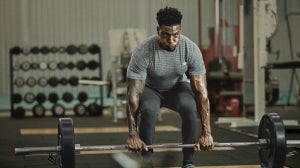
How to Train for Kickboxing
By Myprotein Writer Kelly McFieFully qualified personal trainer, 2nd Dan black belt in Ashihara Fighting karate and kickboxing.
Whether you are a professional kick boxer or an enthusiastic amateur, being a kick boxer demands an extremely high level of physical fitness. More and more big chain gyms are now offering kickboxing classes, or watered down versions of ‘kick fitness,’ emphasising the fact that kickboxing is an epic workout in its own right. But, aside from the training done in class, there is plenty of sport specific training that can be done, at home or in the gym, to improve your kickboxing performance.
Aeorbic and HIIT Fitness
Firstly, cardiorespiratory (or aerobic) fitness is extremely important to any fighter. I often tell my students that they are more likely to ‘lose’ a fight due to being unfit, than they are by getting knocked out or ‘out fought.’ Because of this, it is vital to build a strong base level of aerobic fitness. This can be done through running, swimming, cycling, or any other form of aerobic exercise. The ability to keep going, once your opponent starts to flag, is imperative to a fighter and it is an often over-looked skill, that should be worked on.
Due to the start-stop nature of matches, kickboxing also relies heavily on the anaerobic energy system. Kickboxing matches normally consist of three to twelve rounds, which can last between two and four minutes, with minimal rest in between rounds (normally one minute). The term ‘anaerobic’ basically means that the body’s demand for oxygen is greater than the oxygen available. Therefore, anaerobic exercise burns glycogen to meet the body’s energy requirements. Kick boxers should be able to demonstrate the ability to work at a high intensity for frequent, short spurts with little rest between activities.

Circuit training, high intensity interval training (HIIT) and strength training are excellent ways of improving anaerobic fitness, and can mimic the start-stop pattern of a kickboxing match. This also gets fighters used to working maximally again, after a short recovery period. A sample circuit workout could include twelve different exercise stations, where the participant spends one to two minutes at each station, with a short rest in between exercises. Exercises could include body weight drills like press ups and crunches, plyometric exercises like jump squats, and compound resistance exercises such as cleans and man makers. If you don’t know what a ‘man maker’ is, you must Google it! It will change your workouts forever!
Power and Strength
Explosive power is another key element of kickboxing, and plyometric training should be incorporated into every budding kick boxer’s exercise prescription. Olympic lifts such as the snatch and clean and jerk are also fantastic for increasing explosive strength and power. However, these movements can be very taxing on the central nervous system, and participants should start off using a light weight, until they have mastered the exercises.
Be warned, a strong core is required for these lifts, and they will quickly reveal any weaknesses or areas that require more work! Exercises such as press ups with a clap are great for improving explosive power in the upper body (and improving core strength!), for faster, sharper punches, and box jumps are fantastic for building strength and power in the lower body. It goes without saying that the stronger your legs are, the better your kicks will be.

Flexibility
Speaking of kicks… Stretching and flexibility should be worked on regularly to ensure that fighters are able to deliver devastating kicks to the head, as well as the body and legs. Knee strikes and kicks require excellent flexibility. For example, when executing a roundhouse kick, the hip moves almost through its full range of motion, while the other major leg muscles are all engaged. All this is done, whilst balancing on one leg, of course. For this reason, I would strongly recommend that kick boxers attend some sort of stretching class at least once a week, as well as stretching regularly after sessions and at home – yoga is perfect for this! If you can find a yoga instructor who has some knowledge of kickboxing or martial arts, it is even better.
Balance work is vital to a kick boxer, as the centre of gravity is constantly shifting, while sparring. To help improve balance and improve core strength, kick boxers should be comfortable performing side-to-side and rotational movements. Drills using agility ladders, and exercises such as ‘clock face lunges’ are perfect for this. To perform ‘clock face lunges,’ the participant imagines that they are stood in the centre of a clock, and then lunges to different positions, such as 12 o’clock, 3 o’clock, 6 o’clock, and so on and so forth.

Functional Training
Finally, functional training such as heavy bag work, focus pad drills, shadow sparring, sparring, and technique work should make up a large part of the training programme. Heavy bag work will help to improve the strength and power behind techniques, as well as improving physical endurance. Besides, there’s nothing quite like hitting something really hard, to make you feel awesome! Focus pad drills improve speed, reactions, and targeting, and shadow sparring is an opportunity to put different combinations together, and figure out exactly how they feel, before you try them out against an opponent.
A lot of students dislike shadow sparring, but I truly feel that it is a vital part of training. It helps gets fighters used to staying light on their feet, and practice throwing techniques and combinations from different stances and angles. Lastly, sparring against a variety of different opponents is so important when it comes to fine tuning your fighting skills.
Fighters need to make sure that they can defend themselves against whatever their partner is going to throw, and then counter with an appropriate combination or technique. It doesn’t matter how hard you’ve been training, if you’re knocked out in the first 10 seconds because you couldn’t defend yourself, you’re never going to get the chance to deliver that killer combination you’ve been practicing!

Nutrition
All of this training is going to require a solid nutritional programme that provides enough energy to train, and promotes recovery between sessions. However, a kick boxer’s diet is not substantially different to a normal, healthy, balanced diet. Calorie consumption should be enough to provide energy for training, but not so high that the fighter gains weight! Carbohydrates should be of the wholegrain, complex variety, as opposed to sugar and white bread or pasta, and protein sources should come from lean meats, poultry, fish, and eggs.
Essential fats, in the form of nuts, avocados, olives and oily fish should also make an appearance. Fighters will also benefit from a comprehensive supplement stack including a protein and carbohydrate shake, such as Hurricane XS, to promote recovery and growth, creatine monohydrate for the increased production of adenosine tri-phosphate (used for explosive movements and strength), and glucosamine for healthy joints and cartilage.

Conclusion
So, there you have it. There is a lot more ‘behind the scenes’ work than you may have thought when it comes to how to train for kick boxing. It’s not just about the twelve rounds in the ring; there is a lot more hard work, blood, sweat and tears goes into preparing for that fight than many people realise. However, if you put all the hard work in, the results will be a reward in themselves. You’ll be a fitter, stronger, faster, more powerful version of yourself!
Our articles should be used for informational and educational purposes only and are not intended to be taken as medical advice. If you're concerned, consult a health professional before taking dietary supplements or introducing any major changes to your diet.

Related Articles







